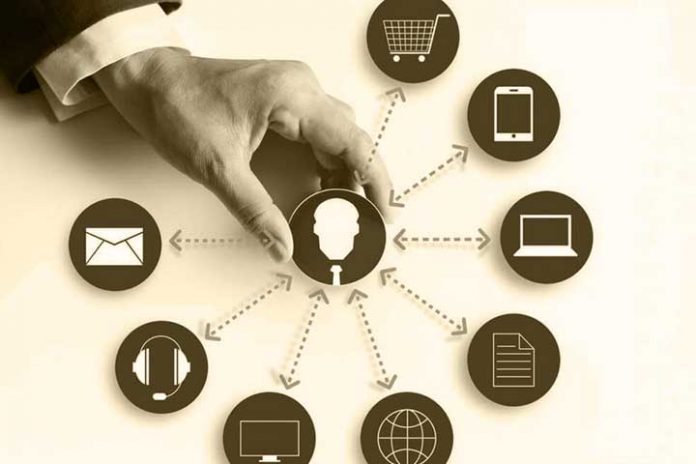In recent years, due to the increased use of smart devices and the growth of e-commerce, the term omnichannel has become increasingly important. Several companies have announced the application of this concept to their business models.
Omnichannel is understood as the unification of the channels in which a brand or business is present so that the customer does not notice the difference between them.
However, lately, a new term has been born that seems to be the evolved version of omnichannel: omni experience.
Unlike omnichannel, omni experience offers a multidimensional ecosystem for companies to extend the experience of their products and services in pursuit of excellence for their customers, according to IDC.
Multichannel: the predecessor of omnichannel and Omni experience
Before omni channel or omni experience existed, multichannel was how customers could access the purchase of a product or service.
Although this modality offered multiple channels for its customers to browse, each space had independent information, so customers had to stay within a single channel to complete a purchase process.
Multichannel was born in a world where smart devices had not yet appeared or were still incipient and had not impacted various aspects of life.
According to a 2016 Deloitte report, in that year, the multichannel approach had already been obsolete for years to face the reality presented by intelligent devices.
This document provides an example of what multichannel is and how it differs from omnichannel.
Previously, when a person wanted to watch a movie, they had several channels, such as open television, cable television or the Internet.
That was a multichannel experience, but not an omnichannel one, because it was impossible to continue viewing the same content on different platforms. Although the user had other options – or channels – to consume audiovisual content, he could not navigate to continue watching the same content on different devices.
Contrary to what happened then, it is now possible to start watching a series on one of the platforms such as Netflix or Amazon Prime Video on one device and continue watching it on another device right where we left off, without the need for any particular configuration. Thanks to omnichannel.
Although this example helps to understand the advantages of omnichannel, this concept is applied to various disciplines such as health, finance, physical and electronic commerce, education, and logistics.
Also Read: What Are The Most Effective Tools For Marketing Automation?
What is omnichannel, and how did it come about?
Some marketing experts point out that the term “omnichannel” was born as a business concept in 2003 when the US retail chain Best Buy decided to focus on customers as a strategy to compete against Walmart’s electronics department.
The company specializing in the sale of electronics was the creator of an approach that took the customer as its centre, both in physical stores and online and in its post-sale customer service.
This concept evolved to cover commercial aspects and the user experience in different sectors of the economy.
In other words, it is a concept that seeks the physical integration of multiple channels of interaction through which a customer can relate to an organization.
This integration allows customers to continue processes and carry them out through any channel, regardless of how they used to start them.
Therefore, omnichannel must be able to support a wide variety of channels available today, but also those that may emerge in the future.
For example, in the retail sector, concepts such as the customer, the order, the product, the inventory, the data, the organization and all the processes must be integrated to interact seamlessly.
This interaction must also result in the generation of information and increasingly more profound knowledge of customer behaviour and statistics that allow the customer to be analyzed as a whole and, thus, make recommendations for a better user experience.
The experience that the user or customer has in each of the channels must be the same, and that is why you should not notice the change when moving from one channel to the other.
The arrival of the Omni experience
As mentioned at the beginning of this article, Omni experience contemplates the combination of interactive experiences between digital businesses, their customers, partners, and employees, among other elements, according to IDC.
The Omni experience fragments its processes so that the product or service can be delivered to the user when they have a specific need.
This allows companies and organizations to meet the needs of their customers and consumers in a more individualized way.
As with omnichannel, omni experience requires companies to invest a significant proportion of their available resources in digitizing their processes.
According to IDC, more than 80% of CEOs of Fortune500 companies include digital transformation as a priority, and more than half of large European organizations spend more than 10 million dollars a year on this process.
The Omni experience not only impacts the service given to the client and how the company can get to know each one of them in-depth and individually. Also, it requires a transformation in the working of the collaborators that are part of the organization.
Deeply and digitally integrating a company also implies integrating internal and external human resources and working so that their mentality evolves towards models of collaboration, connection and relationship between people.
Information management must also change based on the needs that omniexperience dictates to achieve greater integration.
This means that the company must identify the necessary actions so that the information obtained contributes to the digital transformation, according to IDC.
As can be seen, the Omni experience not only implies changes in the design of processes and thinking of models with a high level of integration, but also a change of mentality in the members of the organization – from directors to collaborators – so that the necessary measures can be implemented so that the entire company can move in that direction.
Given that under omni experience, the information generated in one area must be available for use and analysis in other company areas, communication between the different departments must also be fluid, efficient and effective.
On the other hand, since the client and the satisfaction of their needs are a priority under this model, there cannot be only one area specialized in this. The entire organization must know each of the clients in-depth so that, based on the information obtained, they can jointly offer a pleasant experience that generates brand and product loyalty.
Also Read: 5 Tricks To Optimize Your Website And Position Better
A model for Omni experience
To help organizations identify the steps for a successful Omni experience strategy implementation, ICD created a five-stage model:
Level 1 (Ad Hoc): Superficial
At this level, the company has little or no capacity to adapt business models, products and services to create contextualized and individualized experiences in ecosystems.
Level 2 (Opportunist): Enriched
At this level, the company is inconsistent in its customers’ experiences; that is, it does not offer the same experience in the different channels.
Level 3 (Repeat): Multi-dimensional
At this level, participation in high-quality business experiences and ecosystems is a critical imperative in creating new business products and services.
Level 4 (Managed): Amplified
At this level, the company delivers consistent, high-quality product and service experiences through every interaction involving a customer, product, marketplace, partner, or service provider.
Level 5 (Optimized): Disruptive
At this level, the company can repeatedly disrupt and transform market behaviour through continuous innovation and the delivery of contextualized and individualized experiences engagingly and consistently.
IDC explains that for a company to begin to migrate to an omniexperience model, the company must be able to identify where it is today so that it can start working on the different aspects of its processes.
Both the companies that implement omnichannel models and those that have already achieved the establishment of the Omni experience were able to face the changes imposed by the COVID-19 pandemic in different economic activities.
Contrary to companies like Primark, which did not have an e-commerce channel for their customers, they moved from commerce in physical stores to sales through digital channels without much complication.
Application areas of Omni experience
Based on the digital transformation and the adaptation of organizations to the needs of omni experience, some specific activities could benefit more from this new scheme of integration and customer focus.
- Logistics: The omni experience can improve the way inventory and stock are managed at the physical point of sale and how supply chains work to serve customers more quickly and efficiently.
- Sales teams: due to the change in roles in physical stores, they will become managers of product sales to manage the relationship with customers.
- Technology: The Omni experience leads to the use of technology to be at the service of the customer experience and is no longer used solely to achieve the profitability of a particular channel. This ranges from temperature sensors, queue control, self-managed payment services at tellers and the pick-up of products purchased online, among other processes.
- Organization: with omni experience, structures based on transversal processes are generated to leave silo-based structures behind. In this sense, “user experience” areas can be established, which will be in charge of the client’s relationship and share the information with the rest of the company.
- Data (or information): the client ceases to be a channel user and becomes an entity from which we begin to collect increasingly detailed and individualized information to make ad hoc proposals to the specific needs detected.
What are today’s customers looking for?
Although there has been talk about the arrival of smart devices and how this has gradually modified the relationship between companies and customers, it is now time to analyze the other side of the coin: what are customers looking for in this changing reality??
According to marketing experts, the customer is increasingly looking for customer-centric brands with an increasingly human-like brand personality; that is, they want to feel that they can interact with them and that each time they like them. Offer products or services that follow their very particular needs.
In this sense, Marketing 4.0, introduced by Phillip Kotler, points out that the personalized and human-centred user experience is increasingly important.
The challenge of the Omni experience is that not only the users of the products can be integrated into its model, but also the different stakeholders of the companies that decide to embark on the journey towards this new reality.
Also Read: Digital Marketing Trends In 2022


